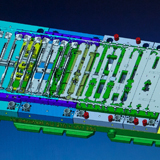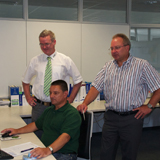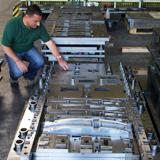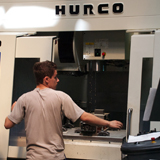VISI - The Most Convincing Solution
A long-established Bavarian tool-maker says two things are essential for its success: it reinvents itself regularly, and industry focussed technology such as VISI software for sheet metal tool design and programming 4 and 5-axis CNC machines.
Meindl-Köhle Umform- und Systemtechnik began making precision tools in 1928, diversifying into producing parts to complement the tool-making division in 1990. Working from a 59,000 square foot production facility in Landsberg, they focus on milled and highly complex sheet metal parts – some of which are sub-assembled – for a range of industries. The in-house tool-making department uses VISI to design, simulate and NC-program a combination of milling and wire EDM machines for the progressive and transfer dies.
They operate a flexible machining system meaning there is no strict separation between contract or prototype manufacturing, fixture construction and tool making. Managing Director Heinz Kleber says: “As a successful provider to the automotive industry, you virtually have to reinvent yourself on a daily basis. Our clients appreciate our creativity and flexibility, while relying on our business continuity and the expert knowledge we’ve developed over decades.”
“We much prefer VISI’s process workflow and menu structure, the system works how our engineers think. VISI provides the complete range of functionality required for plastics and sheet metal processing, allowing us to leverage the value of 3D design.”
Heinz Kleber, Managing Director
He says the fact that they use VISI, from Vero Software, for everything from CAD to CAM, means they can offer everything under one roof – from prototype to serial production.
Their core competencies in this area are milling, grinding and EDM, leading to them designing, manufacturing and assembling between 12 to 15 large progressive and transfer dies a year. Six Mazak machining centres with interchangeable pallet systems and a travel range of up to 1,250 mm in the X-axis form the heart of their milling operation, with larger components, up to 3.5 metres, cut on a Mecof bed-type mill.
Tool-making is mainly carried out on a 3-axis Hurco VMX42 with a vertical spindle, while a small Kunzmann mill is used in the training workshop. Three Fanuc-controlled wire EDMs and a die sinking machine form another vital part of the tool-making operation. State-of-the-art presses, stamping and nibbling machines, plus robot-aided 3D laser welding complement the company’s array of tool-making machines.
Heinz Kleber says the industry focus and VISI’s range of modules to meet all their needs, along with the service from VISI’s German supplier Mecadat, were the decisive factors in their decision to switch to VISI for their tool-making operation, showing it to be the most convincing solution. “We much prefer VISI’s process workflow and menu structure, the system works how our engineers think. VISI provides the complete range of functionality required for plastics and sheet metal processing, allowing us to leverage the value of 3D design.”
“The Advanced Modelling module includes a number of features that are extremely valuable for our industry, especially the option of compensating the spring-back characteristics of sheet metal parts in advance.”
Even in preliminary meetings, client expectations are high, regarding for example, consistent dimensional tolerance of a part across an entire batch. “Using VISI to simulate components in advance allows us to commit to figures in design and quality meetings. It gives us confidence on whether something will work or not and allows us to provide technically sound information at that stage, which wouldn’t have been available in the past.”
Along with the main VISI applications, VISI Blank is used during the quoting phase, which is primarily designed to calculate flat blank cutting sizes for stamping dies. Karl Sichinger, Head of Tool-Making, says: “The customer can usually provide a 3D CAD model which we import into VISI, and if time is of the essence we use VISI Blank to flatten it...processing it by FEM (Finite Element Method) to produce the blank contour and highlight any areas of concern such as wrinkling or areas where tearing may occur.”
As soon as the order is confirmed, VISI Modelling is used to construct the model; then the VISI Progress application generates the 3D strip layout, extrapolates the bending stations and starts creating the die assembly.
Once the design is finished, automatic GA drawings are created and passed to the tool-making department. The design team generates the NC toolpath data which is stored on the server where the programs are retrieved by the machine operators on the shopfloor. Meindl-Köhle has three CAM work stations equipped with VISI Machining 5-axis running on a network license which means VISI can be deployed flexibly at any location across the company.
Heinz Kleber says: “VISI means we can provide everything under one roof, from prototype to serial production. We always try to ensure we’re consulted at the earliest possible stage of a project so we can bring our manufacturing expertise to bear on the design of the parts and assembly. Due to the sheet-metal features offered by VISI Progress and Advanced Modelling, combined with the CAM workflow integration means we’ve significantly improved our ability to respond flexibly and quickly to customer requests.”
About the Company
Name: Meindl-Köhle Umform- und Systemtechnik
Web: www.meindl-koehle.de
Benefits Achieved
- Consistent CAD and CAM data structure to ensure error-free data exchange.
- Advanced Modelling to manage sheet metal spring-back deformation.
- 5-Axis machining software flexibly deployed throughout the company using a network license
Comments
“We much prefer VISI’s process workflow and menu structure, the system works how our engineers think. VISI provides the complete range of functionality required for plastics and sheet metal processing, allowing us to leverage the value of 3D design.”
Heinz Kleber, Managing Director











